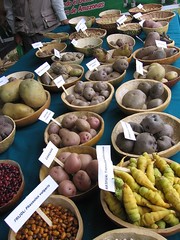There are over 3,000 different types of potato(e) cultivated in Peru. Imagine what Trader Joe's could do with that as a frozen medley.
Monday, September 10, 2007
The Incredible (long) Journey
We´ve had some arduous journey´s on our trip (six buses to a backwoods Honduran brewery featuring fruit beer, the food poisoning Lagos de Montebello expedition and the 12-hour overnight bus to Palenque in Mexico come to mind), but I think we´ve set a new personal record for complexity.
FromVilcabamba, Ecuador to Chachapoyas, Peru we managed to take 1 bus, two combivans, three colectivo taxis, two colectivo pick-ups, three tuk-tuks, 1 taxi,and 1 long walk across a bridge at the border.
We managed to breakfast on fried pig knuckles with yucca, and have a dinner that we thought was pork ribs but turned out to be chicken, covered countless miles on the wrong side of pot-holed, speed-bumped dirt roads, and saw spectacular scenery from soaring mountains to desert valleys to jungly hills to beautiful sunsets peaking through storm clouds over the Andes. Was it worth it? Definitely. Would we do it again? Not in a million years.
It´s What´s for Dinner
 North American pet store meets South American meat market?
North American pet store meets South American meat market? Guinea Pigs were one of the first domesticated animals in the Americas... Not so that every second-grade class could have a mascot, but for its tasty meat with a side dish of potatoes.
We have yet to try this delicacy, but stay tuned for those photos which promise to be a lot less furry and cute.
Friday, September 7, 2007
For Justin

Where the Ladies at?



